August 2016
The Labor Day Weekend project
Aug 31, 2016
I've decided to tackle a project that has been on my to-do list for ages: adding new weighted floors to the ConCor autoracks. Labor Day Weekend is coming up and I think this will be a good time to make some progress on this task.
When the ConCor autoracks came out, I was heavily into the modular N-trak scene, and there was nothing better than seeing a nice, long train of racks making its way along the layout. The stock models looked great and ran fine on the modular layout, once we retrofitted them with KD trucks, wheels, and couplers.
On the mighty MKT, the autoracks are "okay", but tend to be a bit light, and also have a top-heavy "wobble" that bugs me. Many years ago, I purchased 20 of the Alan Curtis autorack upgrade kits, which replaces the plastic floor of the model with a heavier metal casting. The result is a much better tracking car, with none of the "wobble". You can still buy the upgrade kits at N Scale Kits.
I have 18 castings, and that will just about meet my needs. You drill holes in the corners of the floor and, using a coping saw or jewelers saw, cut out the floor. The metal casting is then glued in place, and new trucks and couplers added.
I post some photos of the upgraded cars when I have completed them.
Happy Labor Day, everybody!
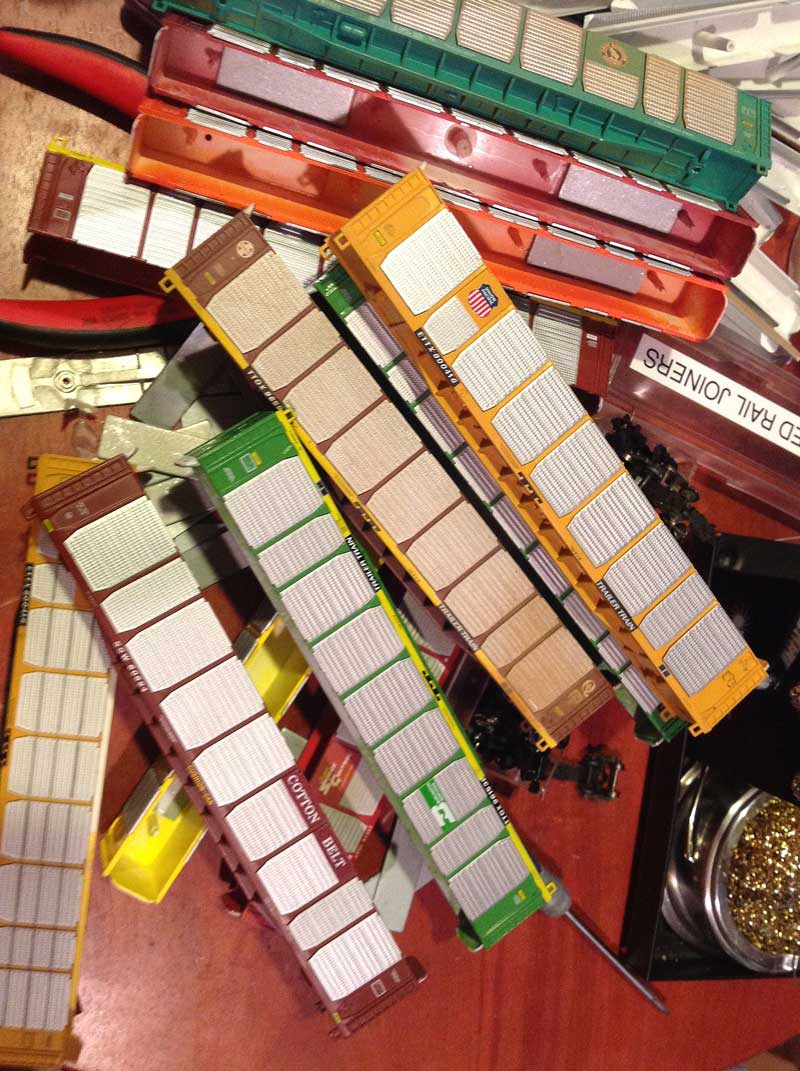
When the ConCor autoracks came out, I was heavily into the modular N-trak scene, and there was nothing better than seeing a nice, long train of racks making its way along the layout. The stock models looked great and ran fine on the modular layout, once we retrofitted them with KD trucks, wheels, and couplers.
On the mighty MKT, the autoracks are "okay", but tend to be a bit light, and also have a top-heavy "wobble" that bugs me. Many years ago, I purchased 20 of the Alan Curtis autorack upgrade kits, which replaces the plastic floor of the model with a heavier metal casting. The result is a much better tracking car, with none of the "wobble". You can still buy the upgrade kits at N Scale Kits.
I have 18 castings, and that will just about meet my needs. You drill holes in the corners of the floor and, using a coping saw or jewelers saw, cut out the floor. The metal casting is then glued in place, and new trucks and couplers added.
I post some photos of the upgraded cars when I have completed them.
Happy Labor Day, everybody!

Be still as a mountain, move like a great river
Aug 30, 2016
I don't talk about it much, but another interest of mine is Tai Chi. I've been practicing Cheng Man-Ch'ing's Yang Style 37 Postures form since 1986, off and on.
I learned the form from Kim Kanzelberger (at the Center States Tai Chi Chuan), who practiced with Benjamin Pang Jeng Lo, who was a long-time student of Chen Man-Ch'ing.
Here is a video of the master himself doing the form.
I learned the form from Kim Kanzelberger (at the Center States Tai Chi Chuan), who practiced with Benjamin Pang Jeng Lo, who was a long-time student of Chen Man-Ch'ing.
Here is a video of the master himself doing the form.
To boldly go where no train has gone before!
Aug 30, 2016 Filed in: Ruminations
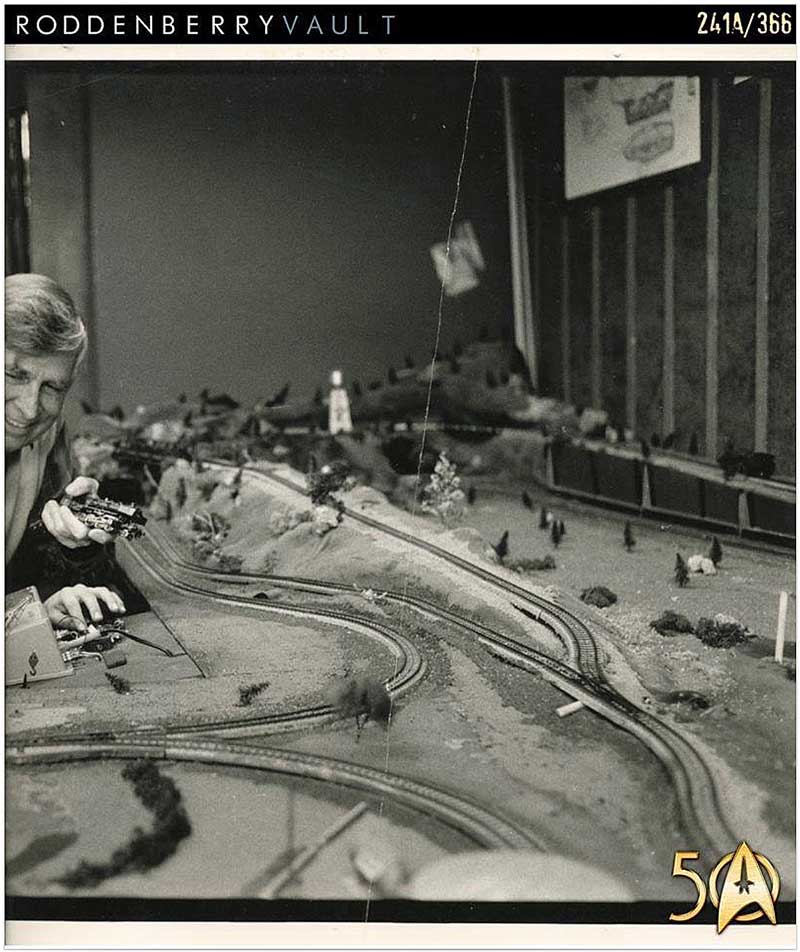
It turns out that Gene Roddenberry was a model railroader!
I've been a fan of Star Trek (in all its incarnations, but specially the Original Series), since the late 60's. The first episode I saw as a child, Charlie X, freaked me out so badly that I couldn't watch the series the rest of the season. I stared watching again the following year.
Can you imagine the layout you could build on the holodeck?!!
Anyway, it looks like Gene had a pretty nice layout there! Live long and prosper!
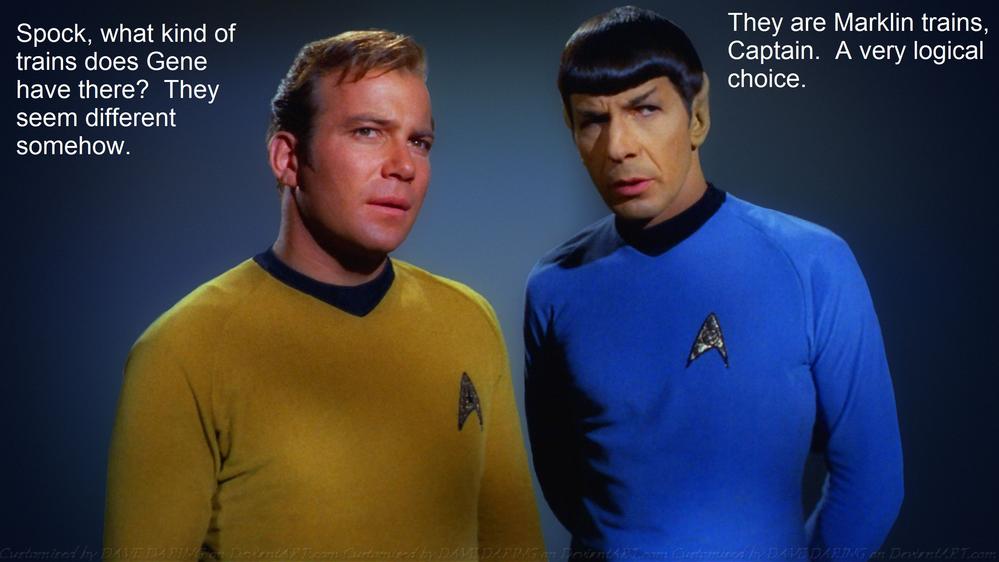
I am switching cars WAY too fast!
Aug 18, 2016 Filed in: Prototype Research
I found the link to this video on Lance Mindheim's great web site. Especially his blog entry on capturing a sense of "mass"
It shows some great switching action and it gives a sense of the overwhelming mass of the cars and power required to move them. It is particularly enlightening to non-rail guys like me, who have no (or little) direct reference when it comes to switching cars.
In his blog, Mr. Mindheim discusses some of the things that modeler can use to capture this sense of mass in switching. In particular, he mentions:
- Layout height - the closer you get the models to eye level, the more realistic the viewing experience will be.
- Sound - capturing the visceral sense of mass using auditory inputs.
- Speed curves - using a broad range of control for slow speeds is achievable with today's decoders and programming tools (such as Decoder Pro)
- Decoder tuning - using Pulse Width Modulation and silent motor control to achieve the smooth slow-running operation required to simulate prototype switching.
I'm a bit of a lead-foot when it comes to switching - I guess that it's just my impatient nature. We tend to scoff at the really slow operators, saying that they are "milking the job" or something like that. But, actually, they have the right idea. The slower switching certainly duplicates the prototype and gives the illusion of mass that we are trying to achieve.
Happiness is a new turnout!
Aug 16, 2016

With the help of my buddy, Joe, I have been slowly upgrading my non-powered turnouts around the layout with the excellent and awesome Kasper MKVII, rev2 turnouts!
We've been working our way around, starting with Columbia, then Westinghouse, then St. Charles, and Rhineland. Last week, the west spur at Mokane received "the treatment" as we call it. The improvement to operation is dramatic.
The original turnouts were hand-thrown, but the new Kasper turnouts all get a tortoise and, of course, powered frogs.
I don't know what you are trying to do, but I can tell you are doing it wrong...
Aug 07, 2016 Filed in: Ruminations
Adding lights at Rhineland and New Franklin
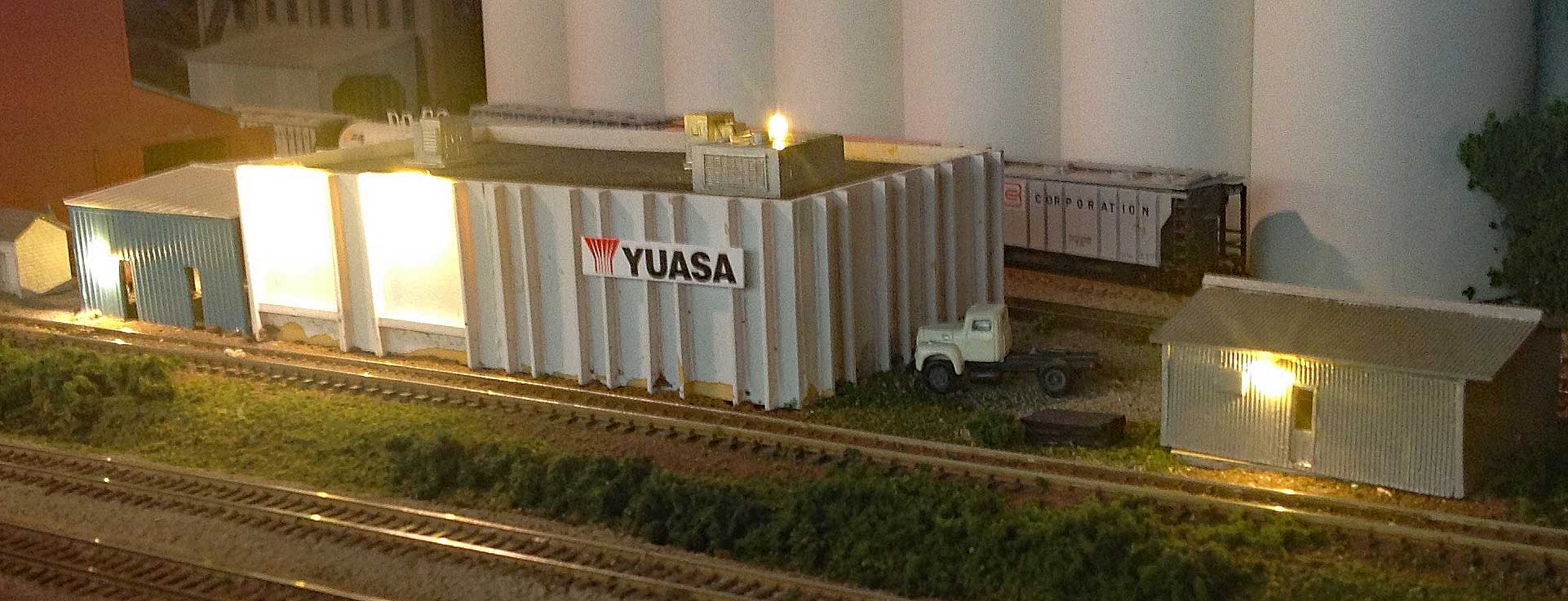
I dimmed the air conditioning light a bit and added a security light to the maintenance building on the right.
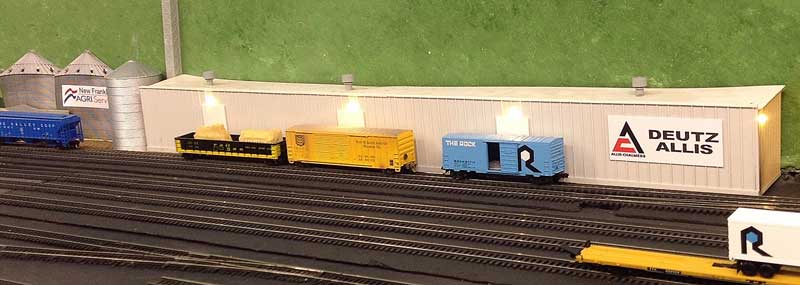
I also added lights to the Duetz Allis farm implement dealer at New Frankln. These are the smaller warm white LED with 2.2K of resistance (12 volt power supply). I really like the look of these lights, and may go back and dim some of the other lights I've recently installed.
Another great work night
Aug 04, 2016 Filed in: Work Night
Wow! What a fun and productive work night we had tonight!
Joe came over to install some sweet Kasper MKVII, rev 2 turnouts at East Rhineland, and Steve, with his out-of-town friend, Matt, helped with scenery and LED lighting.
Pat Lana had previously presented me with a pill bottle full of silica sand from the actual Tavern Rock Quarry area, and Steve used the material to make the layout's Tavern Rock industry look like a dusty, sandy place that it probably was when it was active. The silica sand is very fine - I'm sure that every building, piece of machinery, and rail car was covered with it!

Joe spent the night installing two turnouts at the east end of Rhineland. With the addition of these turnouts, all of Rhineland will benefit from the coveted Kasper MKVI, Rev 2's! Then it's on to Mokane!
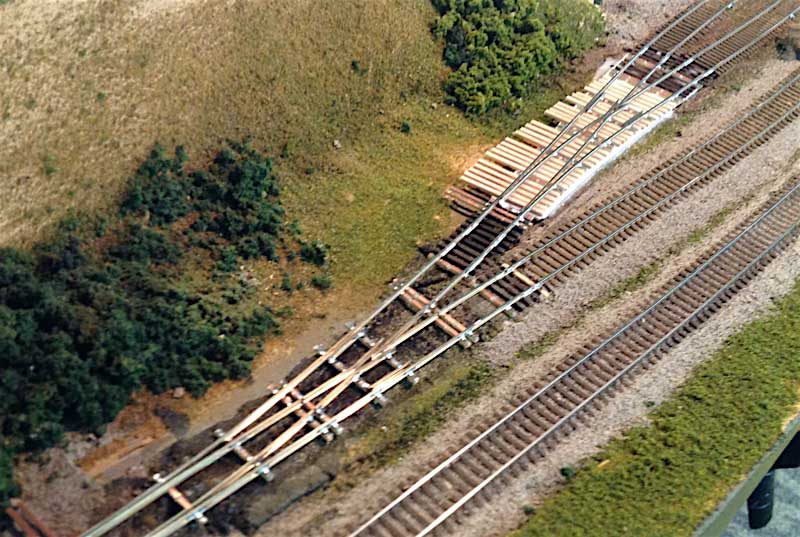
The result of Joe's work tonight at east Rhineland. We still need to add ties, cut the ties to length, add tortoises and wire the track and frog. The locals will really enjoy the silky smooth operation of the Kasper MKVII, Rev 2 turnouts!
While Joe and Steve were busy with their projects, Matt helped me with a project that has been on my list for a while: adding LED lights to the backdrops at St. Charles. We installed a few tonight, but I didn't really have the correct size wire, so we abandoned that project until I get the proper materials.
I switched over to installing LEDs at Yuasa Battery, a small industry in west Rhineland. Using my copper foil bus technique, I quickly installed five LEDs around the building. I really like using the copper foil - it makes wiring so much easier.
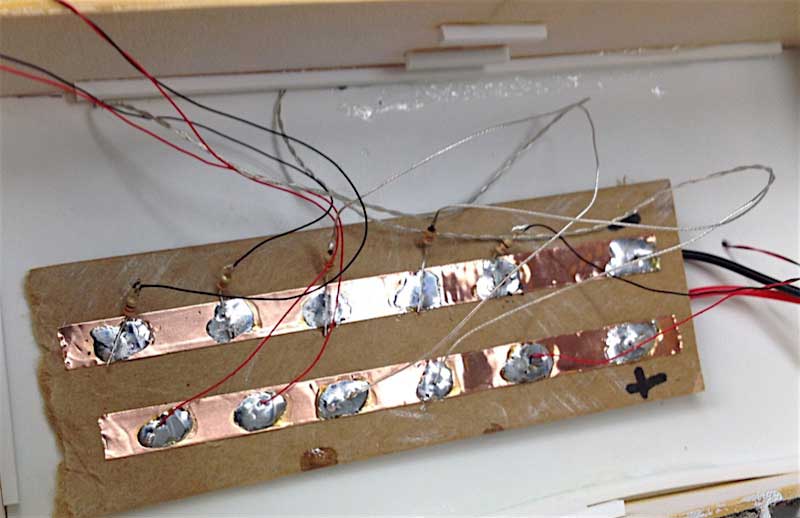
Closeup of the copper foil bus, showing the resistors needed for the LEDs.
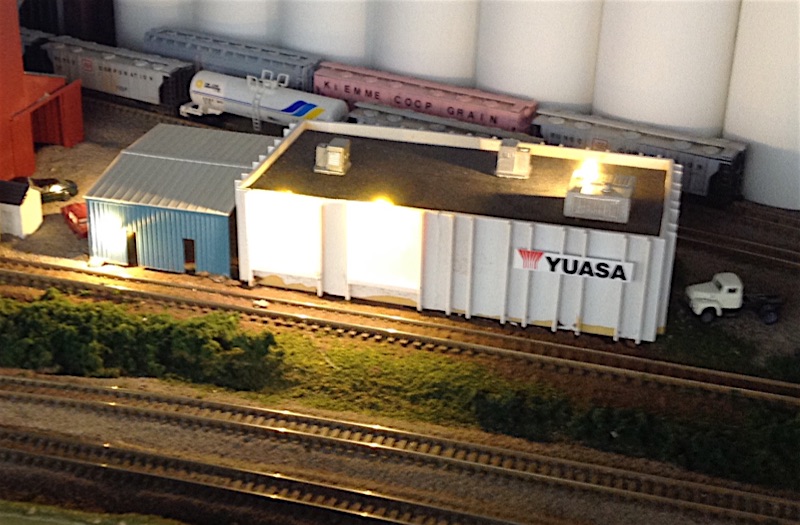
The Yuasa lights are really bright! I may need to increase the value of the in-line resistors to dim them down a bit (especially the roof-mounted security light). Note that the buildings are not in their final locations. I need to adjust the resistor values, then I will plant the buildings.
By now, I know the question that you are dying to ask, "Did you serve Fiddle Faddle, the official snack of the Mighty MKT work nights?" The answer: OF COURSE! It wouldn't be a work session without Fiddle Faddle. We even had Mountain Dew (or, as my daughter says it, Mountain Dude) for Stevie.
Thanks for all your help, guys!
Joe came over to install some sweet Kasper MKVII, rev 2 turnouts at East Rhineland, and Steve, with his out-of-town friend, Matt, helped with scenery and LED lighting.
Pat Lana had previously presented me with a pill bottle full of silica sand from the actual Tavern Rock Quarry area, and Steve used the material to make the layout's Tavern Rock industry look like a dusty, sandy place that it probably was when it was active. The silica sand is very fine - I'm sure that every building, piece of machinery, and rail car was covered with it!

Joe spent the night installing two turnouts at the east end of Rhineland. With the addition of these turnouts, all of Rhineland will benefit from the coveted Kasper MKVI, Rev 2's! Then it's on to Mokane!

The result of Joe's work tonight at east Rhineland. We still need to add ties, cut the ties to length, add tortoises and wire the track and frog. The locals will really enjoy the silky smooth operation of the Kasper MKVII, Rev 2 turnouts!
While Joe and Steve were busy with their projects, Matt helped me with a project that has been on my list for a while: adding LED lights to the backdrops at St. Charles. We installed a few tonight, but I didn't really have the correct size wire, so we abandoned that project until I get the proper materials.
I switched over to installing LEDs at Yuasa Battery, a small industry in west Rhineland. Using my copper foil bus technique, I quickly installed five LEDs around the building. I really like using the copper foil - it makes wiring so much easier.

Closeup of the copper foil bus, showing the resistors needed for the LEDs.

The Yuasa lights are really bright! I may need to increase the value of the in-line resistors to dim them down a bit (especially the roof-mounted security light). Note that the buildings are not in their final locations. I need to adjust the resistor values, then I will plant the buildings.
By now, I know the question that you are dying to ask, "Did you serve Fiddle Faddle, the official snack of the Mighty MKT work nights?" The answer: OF COURSE! It wouldn't be a work session without Fiddle Faddle. We even had Mountain Dew (or, as my daughter says it, Mountain Dude) for Stevie.
Thanks for all your help, guys!
The crossing gate project
Aug 03, 2016
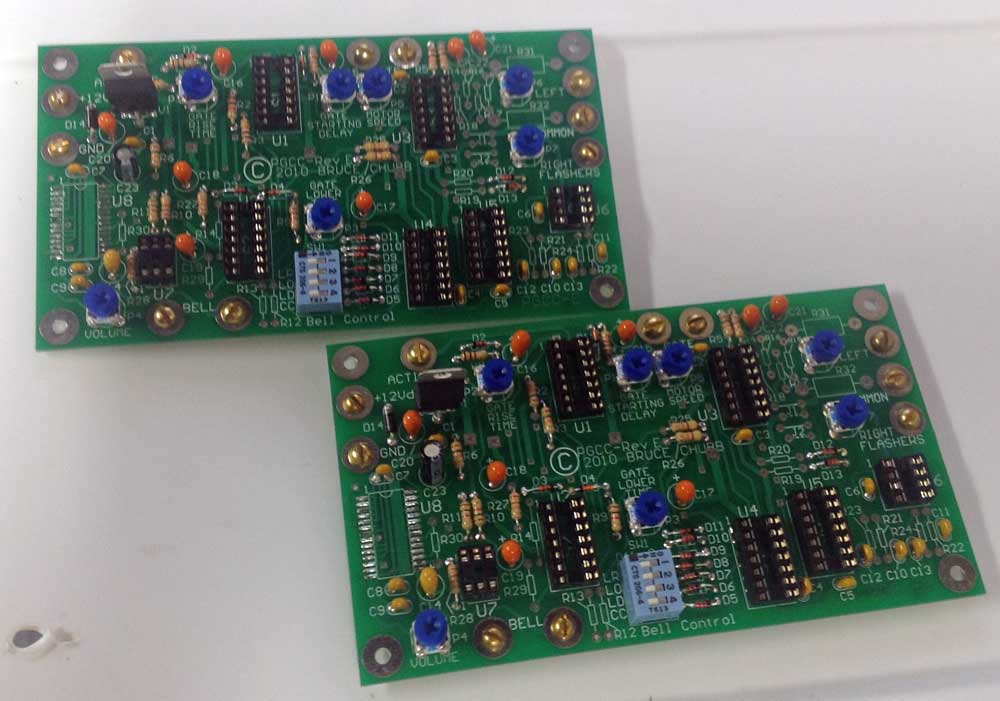
It's been a while since I wrote on the blog. I took a nice vacation to Estes Park. It was good to get away for a while.
One of my vacation projects was to stuff and solder components onto two of the grade crossing control boards, designed and sold by Bruce Chubb.
The grade crossing card is a circuit board that provides flasher control, gate control and user=selectable bell operation. The flashers feature “fad-in and fade-out” function to simulate realistically the incandescent lamp and the “soft start” circuit found on the prototype. The card has controls to adjust flasher brightness, gate speed and an adjustable delay between when the flashers start and gates begins their decent. A built-in DIP switch enables selecting between four different prototypical bell operational sequences. The grade bell sound is provided by an integrated sound IC pre-recorded from a prototype crossing bell. It's a pretty sweet piece of electronics.
Before my vacation, I had ordered most of the required components (those that I didn't already have in my surplus parts stash, and I spent an afternoon or two stuffing the boards and soldering. I still need a few oddball resistors to complete the boards, but they are nearly finished.
When finished, I intend to place one board at the existing crossing at the east end of Mokane, and the other board in St. Charles. It will add some nice animation and sound to the layout!
I'll update the block with more information about these cards later.